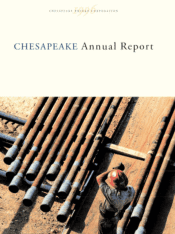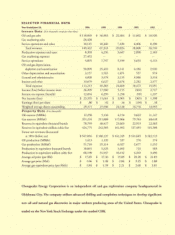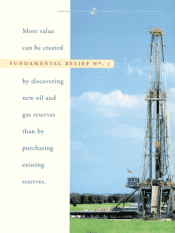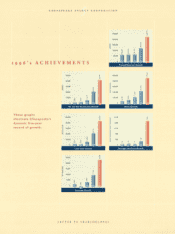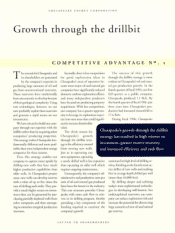Chesapeake Energy 1996 Annual Report Download - page 9
Download and view the complete annual report
Please find page 9 of the 1996 Chesapeake Energy annual report below. You can navigate through the pages in the report by either clicking on the pages listed below, or by using the keyword search tool below to find specific information within the annual report.
CHESAPEAKE ENERGY CORPORATION
Growth through the drilibit
COMPETITIVE ADVANTAGE N°. i
Therewards for Chesapeake and
its shareholders are generated
by the company's expertise in
producing large amounts of oil and
gas from unconventional reservoirs.
These reservoirs have traditionally
been uneconomic to develop because
of their geological complexity. Using
new technologies, however, we can
now profitably exploit these reservoirs
and generate a rapid return on our
investments.
We have elected to btiild our com-
pany through our expertise with the
drillbit rather than by acquiring other
companies producing properties.
This strategy makes Chesapeake fun-
damentally different and more prof-
itable than most independent energy
companies for three reasons.
First, this strategy enables our
company to capture more upside by
drilling new wells that have much
higher prodtictive capabilities than
older wells. In Chesapeake's project
areas, new wells can develop reserves
with a valtie of up to five times the
cost of drilling such wells. They pro-
vide a much higher return on invest-
ment than can be generated by pur-
chasing partially depleted wells from
other companies and then attempt-
ing to stimulate marginal production
increases.
Secondly, there is less competition
for good exploration ideas in
Chesapeake's areas of operation be-
cause most major oil and natural gas
companies have significantly reduced
domestic onshore exploration efforts,
and many independent producers
have focused on producing property
acqtlisitions. With less competition,
our company has a greater opportu-
nity to leverage its exploration exper-
tise into new areas that could signifi-
cantly increase shareholder
value.
The third reason for
Chesapeake's growth
through the drilibit strat-
egy is the efficiency created
from owning new wells.
J ust as in operating any
new equipment, operating
a newly drilled well is less expensive
than operating an older well which
requires ongoing maintenance.
Consequently, the company's ad-
ministrative and production costs per
unit of oil and natural gas prodticed
have been the lowest in the industry.
This cost structure provides Chesa-
peake with more cash flow to rein-
vest in its drilling program, thereby
providing a key component of the
funding required to continue the
company's growth.
LETTER TO SHAREHOLDERS
The success of this growth
through the drillbit strategy is most
evident in Chesapeake's oil and natu-
ral gas production growth. In the
fourth quarter of fiscal 1993, our first
full quarter as a public company,
Chesapeake produced 1 .1 Bcfe. By
the fourth quarter of fiscal 1996, just
three years later, Chesapeake's pro-
duction had increased sixteenfold to
17.6 Bcfe.
Dtiring fiscal 1 996, Chesapeake
Chesapeake's growth through the drilibit
strategy has resulted in high returns on
investment, greater reserve recovery,
and increased efficiency and cash flow.
continued its high level ofdrilling ac-
tivity, finishing as the fourth most ac-
tive driller of new wells and ranking
first in average depth drilled per well
(more than 16,000 feet).
By drilling deeper and utilizing
today's most sophisticated technolo-
gies in developing well-known, hut
underexploited reservoirs, our com-
pany can reduce exploration risk and
increase the potential for discovering
large amounts of new oil and natural
gas reserves.

